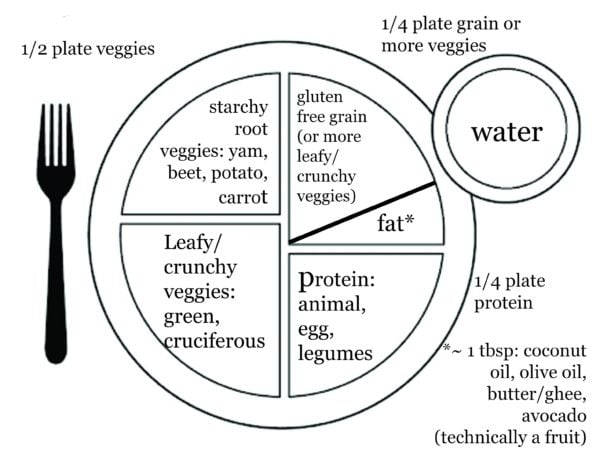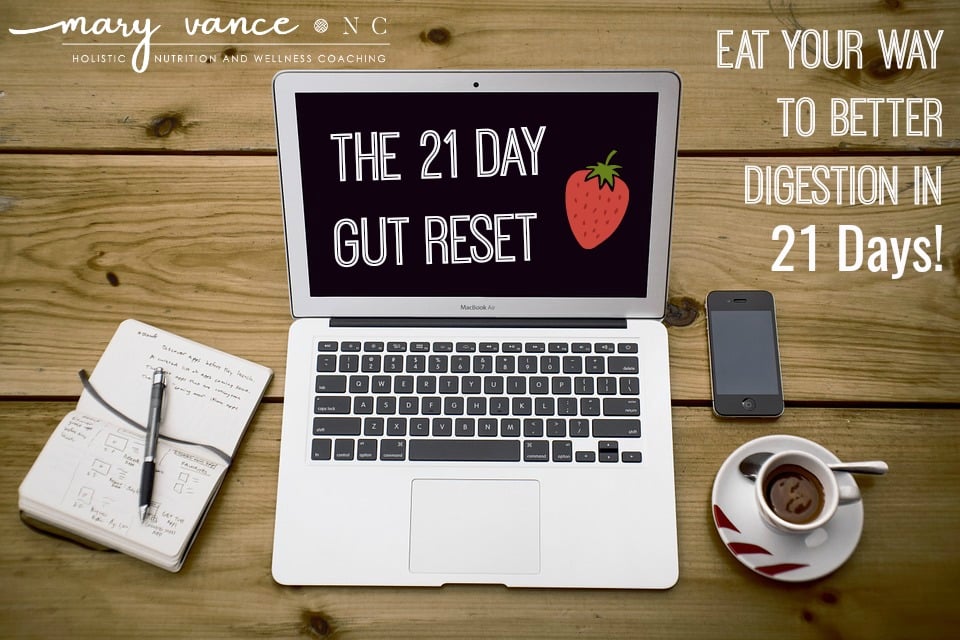
One of my favorite lunches: quinoa, pasture raised braised pork, pickled cabbage, avocado, and summer squash.
There is so much confusion around what should I eat? We have the USDA pyramid that tells us to make bread, pasta, and whole grains a good chunk of our meals (though to their credit, they do recommend as many veggies as possible); some paleo folks tell us that meat should be half our plate; we’re still confused about whether or not red meat causes cancer, and should we even eat meat? SO: How can we design and build a healthy plate?
Although there is never a one size fits all approach for diet (this post may help you determine your ideal diet), there are a few guidelines we can all follow to be healthier and feel better. What you should eat depends on your age, gender, goals, and unique physiology, but we can all benefits from the following principles:
- Make one half your plate vegetables of all kinds. Longevity studies tell us that about 50-55% of our diets should contain healthy carbs (source) like vegetables, legumes, fruit, gluten free grains (I recommend grains sparingly for most people). Choose from the low carb, leafy varieties such as kale, chard, spinach, collards, cucumber, celery, peppers (anything crunchy) and a good mix of higher carb starchy root veggies like beets, potatoes, parsnip, winter squash, yams. For the average person I recommend unlimited low carb veggies and a serving of the starchies at lunch or dinner, anywhere from 1/2 cup to 1 cup or more, depending on your size/gender/activity level.
- Get a good chunk of protein at each meal, particularly breakfast and lunch. You’re expending the most energy during the day, so this is when you need to take in the majority of your calories. Typically one half your body weight in grams of protein is a good rule of thumb for active adults.
- Get a good fat that you either used to cook your meal or that you use alongside your meal. I cook veggies in olive oil or coconut oil and often adorn things with avocado. Butter and ghee are great too. Dress salads with avocado oil. I use sesame oil occasionally too, but I avoid refined vegetable oils and most seed oils because they’re high in the omega 6 fats that cause inflammation when over-consumed.
- Grains and legumes are great for some, not so great for others. When appropriate, I only recommend the gluten free whole grains such as wild rice, quinoa, buckwheat, millet, amaranth. Some feel great without grains; others need more carb to feel good and satisfied. Legumes like lentils and beans are excellent sources of phytonutrients and fiber, but some people, especially those with inflammatory digestive issues, have trouble digesting legumes (and grains for that matter). If grains and legumes cause bloating, fatigue, or other GI issues, try avoiding them for a few months and then try again. Address the root of your GI issues meantime. Some people just feel better with minimal or no grains long term, and that’s fine too.
- Fruit is a great snack, but don’t overdo it. A couple pieces daily should suffice. The berries and citrus especially offer great benefit. I eat fruit most often in smoothies, and I use a berry mix.
- Add in as many super foods as you can: turmeric, avocado, walnuts, chia seeds, garlic & onion, herbs & spices, green tea, fermented foods and drinks (like this coconut water kefir, a favorite of mine for probiotics), dark chocolate, and green vegetable juices, to name a few aside from the typical salmon, kale, blueberries rec. Here is my list of the healthiest foods on the planet.
- Dairy: I only recommend dairy after an elimination diet wherein one has determined if there is a sensitivity present. If not, dairy is fine sparingly (3 or so times a week). Fermented forms are best: kefir, plain, full fat yogurt. Include sheep and goat, too. Do not use dairy if you have acne or struggle with hormonal issues such as PCOS. Here are my thoughts on dairy.
If you choose to be vegetarian (which doesn’t work well for everyone or even the majority), you’ll need to take special considerations to get a wide spectrum of amino acids and enough protein. Choose from legumes, gluten free grains, nuts & seeds, occasional fermented soy (natto, tempeh). Protein smoothies made with hemp and pea protein are great too. Read my article on whether or not vegetarianism is right for you. Here’s a hint: if you’re gained weight or developed digestive issues on your vegetarian plan, it may not be the best option for you. I don’t recommend vegan or raw food diets.
How to Make a Healthy Plate
Put it all together!
Here’s an example chart I give my clients to help them build meals. This is just a basic chart; quantity and food groups vary depending on the person and if they’re working to reverse or heal health issues.
| Foods to Enjoy | Comments | Foods to Avoid | |
| Protein
Choose organic/free range/hormone free |
Beef/bison, pork, lamb,poultry (chicken, turkey, game hen), wild fish/shellfish: oysters, shrimp
Cage free eggs Organ meats (liver) |
Meats: grass fed
Poultry: eat both dark & white meats Fish: choose wild over farmed |
Deep fried or breaded
Canned tuna Conventionally raised meat, farmed fish and shrimp |
| Carbohydrate Vegetables
Organic where possible
|
Low carb/leafy:
Swiss Chard, kale, mustard greens, spinach, onions, cruciferous (broccoli, cauliflower), summer squash, cucumber, High carb/starchy: potatoes, beets, carrots, parsnip, winter squash |
A good mix of raw, cooked, starchy, leafy | Canned vegetables. |
| Carbohydrate
Fruits Organic where possible |
Whole, fresh fruits in moderation.
Best choices: berries, stone fruit, citrus, melon |
Choose seasonal, local fruits. | Avoid dried fruits, as they tend to spike blood sugar. |
| Carbohydrate
Grains & legumes: 1/2 – 1 cup per 2 meals daily Organic, not genetically modified (non-GMO)
|
Beans & lentils, quinoa, Amaranth, arrowroot, buckwheat, millet, GF oats | Avoid too many processed gluten free products (GF cookies, crackers, breads, snacks, etc)
|
White flour, wheat flour, spelt, barley, rye, kamut, teff.
Avoid refined carbs: sugar, corn syrup |
| Fats/Oils
Cold pressed |
Extra virgin olive oil, unrefined coconut oil, avocado, sesame oil, ghee/butter if tolerated | Include good fats/oils with each meal
|
Margarines, hydrogenated & partially hydrogenated oils, canola, vegetable oils, seed oils |
| Drinks
|
Filtered water,
Herbal & green teas, beet kvass, green vegetable juices |
Water is the best beverage to drink; it helps to optimize digestive function & elimination. | fruit juices, all alcohol for best results |
| Super Foods
|
Spices: cinnamon, ginger, turmeric, cayenne; spirulina; raw kraut
Sea vegetables like nori, wakame, hijiki, kelp; bone broth |
Use as an accompaniment
to meals.
|
Please share and +1!

Mary Vance is a Certified Nutrition Consultant and author specializing in digestive health. She combines a science-based approach with natural therapies to rebalance the body. In addition to her 1:1 coaching, she offers courses to help you heal your gut and improve your health. Mary lives in San Francisco and Lake Tahoe in Northern California. Read more about her coaching practice here and her background here.






